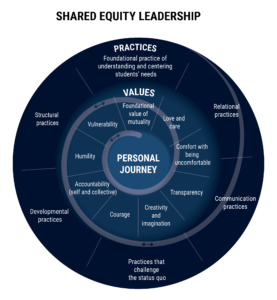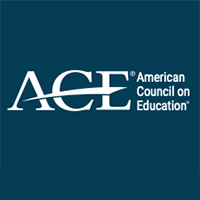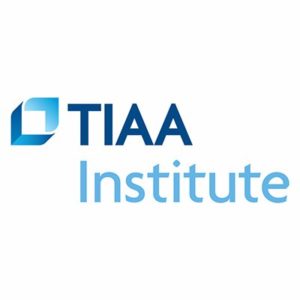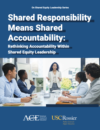Background and Goals | Research Team | Partner | Funders | Reports
 Building a Culture of Shared Equity Leadership in Higher Education is a multi-year project that will provide insights into the opportunities, challenges, structures, context, roles and other core features of shared equity leadership in higher education. This project builds on earlier work on shared leadership and supporting diverse students in higher education that were also a partnership between Pullias and ACE.
Building a Culture of Shared Equity Leadership in Higher Education is a multi-year project that will provide insights into the opportunities, challenges, structures, context, roles and other core features of shared equity leadership in higher education. This project builds on earlier work on shared leadership and supporting diverse students in higher education that were also a partnership between Pullias and ACE.
What is ‘Shared Equity Leadership?’
Shared equity leadership (SEL) is a leadership approach that scales diversity, equity, and inclusion (DEI) work and creates culture change by connecting individual and organizational transformation. Individuals embrace a personal journey toward critical consciousness to become equity-oriented leaders. Collectively, leaders embody a set of values and enact a set of practices that form new relationships and understandings, ultimately working to dismantle current systems and structures that inhibit equitable outcomes.
Background and Goals
In 2020, the American Council on Education (ACE), in collaboration with the Pullias Center for Higher Education, received a generous grant from the Alfred P. Sloan Foundation aimed at developing practice-based insights relative to shared equity leadership in higher education. The resulting report released through ACE, Shared Equity Leadership: Making Equity Everyone’s Work, was released in March 2021.
Pullias Center Director Adrianna Kezar was an author on this report, which suggested that the work of improving equity outcomes of systemically-marginalized students is at its most effective when leadership teams across campus take collective responsibility in developing and moving the diversity, equity, and inclusion agenda forward.
SEL was further explored in our second report, Organizing Shared Equity Leadership: Four Approaches for Structuring the Work. In this report we highlight four distinct ways to structure SEL that we observed from our participating institutions. We lay the groundwork for understanding these structures by first describing some of the more common or traditional ways that diversity leadership has been structured in higher education, followed by a brief overview of shared leadership structures and then a detailed analysis of the four SEL models.
The SEL Library of Work
The Pullias Center and ACE have continued exploring Shared Equity Leadership (SEL) with further funding from the Arthur Vining Davis Foundations. This phase of the SEL project has resulted in a series of reports aimed at examining different roles played by staff, faculty and administrators, and will look at how context shapes their work.
Emotional Labor in Shared Equity Leadership Environments: Creating Emotionally Supportive Spaces is the sixth and final SEL report in our series, released in June 2023. In this research brief, we explore what emotional labor looks like in environments where responsibility for DEI leadership is broadly distributed and shared across multiple campus stakeholders, rather than siloed or isolated in a single person or office.
In addition, our June 15 webinar discussed what emotional labor looks like in an environment where responsibility for diversity, equity, and inclusion (DEI) leadership is broadly distributed. “Emotional Labor in Shared Equity Leadership Environments: Creating Emotionally Supportive Spaces” webinar (click on link to watch the webinar recording) details how the emotional burden of DEI work can be minimized when leaders work in community together.
“Capacity Building for Shared Equity Leadership: Approaches and Considerations for the Work,” the fifth report in the SEL series, was released in January 2023. In it, we explore ways to build capacity of SEL in higher education. Explore Capacity Building further by watching our webinar (January 2023) with ACE.
“Leading for Equity from Where You Are: How Leaders in Different Roles Engage in Shared Equity Leadership” is our fourth report in the Series, released in November 2022. This report examines the ways that leaders in different campus roles contribute to SEL efforts. Learn more about roles and SEL in our Q&A with Taffye Benson Clayton, VP and associate provost for inclusion and diversity at Auburn University: “In my role, shared equity leadership is a next step evolution in my individual professional and institutional DEI work.” Read more, here.
“Shared Responsibility Means Shared Accountability: Rethinking Accountability Within Shared Equity Leadership” is our third report in the Series, released in August 2022. In this report, we describe the ways that campuses implementing SEL are grappling with accountability in environments where responsibility for DEI work is broadly distributed.
Don’t miss the Shared Equity Leadership Toolkit. The Toolkit builds on the Shared Equity Leadership: Making Equity Everyone’s Work report, and is designed to help leaders determine their strengths and weaknesses—and those of their team—in the values and practices necessary to effectively practice shared equity leadership.
The continued work will provide a research-informed foundation upon which higher education leaders can implement institutional policies and practices to best support the needs of all postsecondary education students.
Read our Blog Posts on Shared Equity Leadership
Capacity Building for Shared Equity Leadership
January 9, 2023
By Jordan Harper, Natsumi Ueda, and Elizabeth Holcombe
Join us for a webinar Jan. 31 to discuss our upcoming report on capacity building for Shared Equity Leadership. Register here.
Over the past three years, the American Council on Education (ACE) and the University of Southern California (USC) have been working together to study new ways that campuses are thinking about leadership for diversity, equity, and inclusion (DEI). Our research team identified an approach called shared equity leadership (SEL), which spreads responsibility for DEI work broadly across campus and creates culture change by connecting individual and organizational transformation.
SEL represents a departure from traditional approaches to leadership, which tend to focus on individual leaders’ traits and behaviors, rather than leadership as a collective process, and to ignore or downplay DEI concerns. As a result, campuses interested in engaging in SEL must think carefully about the ways they might need to build capacity to do this work effectively. Capacity building for SEL is an ongoing investment at multiple levels meant to support and develop a repertoire of knowledge, skills, and dispositions to collectively lead equity-minded change efforts.
Our forthcoming report outlines strategies at each level that can help institutions build capacity for SEL. These strategies fall into three main categories—personal, collective, and organizational. (Read more)
Accountability for Campus Equity Is Everyone’s Work
September 15, 2022
By Adrianna Kezar and Elizabeth Holcombe
More than two years after the murder of George Floyd and the racial reckoning that arose in its wake, urgency around equity-minded and anti-racist work in higher education continues to increase.
Student and community stakeholders are pressing college and university leaders for evidence of action and increased accountability around diversity, equity, and inclusion (DEI) work. Data that show progress on key DEI indicators are becoming an expectation—not just demonstrating that the work is occurring, but also whether it is making a difference. National players are starting to chime in, including funders such as the Bill & Melinda Gates Foundation, which is looking at equity gaps; the Alfred P. Sloan Foundation and its focus on equitable pathways; and policymakers such as the NASH Equity Action Framework. Even accreditors are weighing in through the Council for Higher Education Accreditation’s commitment to hold institutions accountable for equitable outcomes. Projects such as the Equity Scorecard have been pressuring campuses for years to look at and track data disaggregated by race and ethnicity to ensure that racial equity gaps are narrowing and not persisting. (Read more)
Organizing Shared Equity Leadership: How to Structure the Work
June 2, 2022
By Elizabeth Holcombe and Adrianna Kezar
As college and university campuses continue to work to transform themselves into more equitable, just, and anti-racist spaces, leaders are grappling with the best ways to undo structural inequities that have become deeply entrenched over time. In recent years, campuses have focused on the chief diversity officer (CDO) position as a mechanism for leading change on diversity, equity, and inclusion (DEI). (Read more)
Shared Equity Leadership: Transforming Campus Communities Is a Collective Responsibility
May 24, 2021
By Darsella Vigil, Elizabeth Holcombe, and Adrianna Kezar
For more than two decades, colleges and universities have seen considerable increases in enrollment for students of color. However, equity gaps persist at alarming rates between these students and their white counterparts. Ongoing health, racial, and economic crises—the COVID-19 pandemic, the murders of unarmed Black Americans at the hands of police, the Capitol insurrection—have only further exacerbated these inequities and underscored the critical role higher education plays in either addressing or overlooking systemic racism, both on campus and in the broader community. Institutions and leaders must substantially transform to address these persistent inequities and find practical solutions for complex societal challenges. (Read more)
Pullias Research Team
Adrianna Kezar
Director
Darsella Vigil
ACE
Elizabeth Holcombe
Senior Postdoctoral Research Associate
Jordan Harper
Research Assistant
Natsumi Ueda
Research Assistant
Partner
The American Council on Education (ACE) is a membership organization that mobilizes the higher education community to shape effective public policy and foster innovative, high-quality practice. As the major coordinating body for the nation’s colleges and universities, ACE’s strength lies in its diverse membership of more than 1,700 colleges and universities, related associations, and other organizations in America and abroad. ACE is the only major higher education association to represent all types of U.S. accredited, degree-granting institutions: two-year and four-year, public and private.
(ACE) is a membership organization that mobilizes the higher education community to shape effective public policy and foster innovative, high-quality practice. As the major coordinating body for the nation’s colleges and universities, ACE’s strength lies in its diverse membership of more than 1,700 colleges and universities, related associations, and other organizations in America and abroad. ACE is the only major higher education association to represent all types of U.S. accredited, degree-granting institutions: two-year and four-year, public and private.
Funders
The Arthur Vining Davis Foundations were organized in 1952 and are supported by two trusts established by Mr. Arthur Vining Davis. The Foundations aim to bear witness to Mr. Davis’ successful corporate leadership and his ambitious philanthropic vision. Since their inception, the Foundations have given over 3,800 grants totaling more than $300 million to colleges and universities, hospitals, medical schools, and divinity schools.
The ALFRED P. SLOAN FOUNDATION is a not-for-profit, mission-driven grantmaking institution dedicated to improving the welfare of all through the advancement of scientific knowledge. Established in 1934 by Alfred Pritchard Sloan Jr., then-President and Chief Executive Officer of the General Motors Corporation, the Foundation makes grants in four broad areas: direct support of research in science, technology, engineering, mathematics, and economics; initiatives to increase the quality and diversity of scientific institutions and the science workforce; projects to develop or leverage technology to empower research; and efforts to enhance and deepen public engagement with science and scientists. sloan.org | @SloanFoundation

The TIAA Institute helps advance the ways individuals and institutions plan for financial security and organizational effectiveness. The Institute conducts in-depth research, provides access to a network of thought leaders, and enables those it serves to anticipate trends, plan future strategies and maximize opportunities for success. To learn more about our work and engage with our community of thought leaders, please visit our website at www.tiaainstitute.org and follow us on Twitter at @TIAAInstitute.
Research Assistant
Reports

Emotional Labor in Shared Equity Leadership Environments: Creating Emotionally Supportive Spaces
Darsella Vigil, Elizabeth Holcombe, Natsumi Ueda, Adrianna Kezar
Pullias Center for Higher Education (2023)
In this research brief, part of the On Shared Equity Leadership series, we explore what emotional labor looks like in environments where responsibility for DEI leadership is broadly distributed and shared across multiple campus stakeholders, rather than siloed or isolated in a single person or office. While the challenging emotions and emotional labor that accompany DEI work do not disappear in SEL environments, we did find some evidence that the burden is minimized by working in community with other leaders who share the labor. The emotional labor that does still occur is often less burdensome and overwhelming to those involved because of the support they have from colleagues who share both the work and the emotions that come with it. This report first summarizes some of the existing research on emotional labor and DEI work before highlighting the ways in which SEL can alleviate different types of emotional labor.
Categories: Shared Equity Leadership, Equity and Leadership
shared equity leadership adrianna kezar equity and leadership
Download 1.77 MB 19975 Downloads

Capacity Building for Shared Equity Leadership: Approaches and Considerations for the Work
Elizabeth Holcombe, Jordan Harper, Natsumi Ueda, Adrianna Kezar, Jude Paul Matias Dizon, Darsella Vigil
Pullias Center for Higher Education (2023)
This report, the fifth in the On Shared Equity Leadership series, explores ways to build capacity for the work of shared equity leadership (SEL) in higher education. SEL is a leadership approach that scales diversity, equity, and inclusion (DEI) work and creates culture change by connecting individual and organizational transformation. Capacity-building efforts help leaders develop a repertoire of knowledge, skills, and dispositions to collectively lead equity-minded change efforts on campus. To create environments where SEL can thrive, campuses need to build capacity for both shared leadership and DEI. This distinction is important because shared leadership capacity building involves working and leading collaboratively, whereas capacity building for DEI is more focused on the knowledge, skills, and critical consciousness necessary to make progress toward DEI-related goals. Additionally, capacity for SEL must be built at multiple levels—the personal or individual level, the collective or team level, and the organizational level. The report identifies distinct strategies for building capacity at each level and indicates whether they can build capacity for shared leadership, DEI, or both.
Categories: Equity and Leadership, Leadership
Equity & Leadership shared equity leadership equity and leadership leadership
Download 2.29 MB 12446 Downloads

Leading for Equity from Where You Are: How Leaders in Different Roles Engage in Shared Equity Leadership
Elizabeth Holcombe, Adrianna Kezar, Jordan Harper, Darsella Vigil, Natsumi Ueda, Jude Paul Matias Dizon
Pullias Center for Higher Education (2022)
In this report, the fourth in the On Shared Equity Leadership series, we describe the ways that leaders in different campus roles contribute to shared equity leadership (SEL) efforts. SEL is a leadership approach that scales diversity, equity, and inclusion (DEI) work and creates culture change by connecting individual and organizational transformation. Individuals embrace a personal journey toward critical consciousness to become equity-oriented leaders. Collectively, leaders embody a set of values and enact a set of practices that form new relationships and understandings, ultimately working to dismantle current systems and structures that inhibit equitable outcomes. This report examines roles from both a functional perspective (e.g., faculty, student affairs, and DEI-specific roles) and from a positional view (e.g., senior-level, mid-level, and ground- level leaders), and it highlights the ways in which different values and practices are especially important for leaders in particular roles.
Categories: Equity and Leadership, Leadership
shared equity leadership equity and leadership leadership
Download 2.08 MB 14802 Downloads

Shared Responsibility Means Shared Accountability: Rethinking Accountability Within Shared Equity Leadership
Adrianna Kezar, Elizabeth Holcombe, Darsella Vigil
Pullias Center for Higher Education (2022)
In this report, the third in the On Shared Equity Leadership series, we describe the ways that campuses implementing SEL are grappling with accountability in environments where responsibility for DEI work is broadly distributed. What does it mean when more people are in charge of accomplishing DEI goals? How do we effectively and honestly measure progress on DEI goals? How do we ensure we are measuring the right goals while simultaneously holding the right people accountable for advancing campus equity goals? This report examines these questions and more, providing many examples for campuses struggling to rethink their accountability systems as they broaden responsibility for DEI work.
Categories: Equity and Leadership, Leadership
shared equity leadership equity and leadership
Download 2.30 MB 17774 Downloads

Shared Equity Leadership Toolkit
Adrianna Kezar, Elizabeth Holcombe, Darsella Vigil
Pullias Center for Higher Education (2022)
This toolkit accompanies the report Shared Equity Leadership Making Equity Everybody’s Work, and enables leaders to reflect on their personal journey toward a critical consciousness. Through the SEL Toolkit, leaders can identify their own strengths and potential areas for growth in the values and practices that are necessary to effectively practice shared equity leadership. Leaders can assess and reflect on their strengths individually as well as map the strengths present in their team or group.
Categories: Equity and Leadership, Leadership
shared equity leadership equity and leadership
Download 781.70 KB 14090 Downloads

Organizing Shared Equity Leadership: Four Approaches to Structuring the Work
Elizabeth Holcombe, Adrianna Kezar, Jude Paul Matias Dizon, Darsella Vigil, Natsumi Ueda
Pullias Center for Higher Education (2022)
In this report, the second in the On Shared Equity Leadership series, we highlight four distinct ways to structure Shared Equity Leadership (SEL) that we observed from our participating institutions. We lay the groundwork for understanding these structures by first describing some of the more common or traditional ways that diversity leadership has been structured in higher education, followed by a brief overview of shared leadership structures and then a detailed analysis of the four SEL models. We conclude with examples that show how institutions can reward and incentivize the development of these models.
Categories: Equity and Leadership, Leadership
shared equity leadership equity and leadership
Download 942.10 KB 16638 Downloads

Shared Equity Leadership: Making Equity Everyone's Work
Adrianna Kezar, Elizabeth Holcombe, Darsella Vigil, and Jude Paul Mathias Dizon
Pullias Center for Higher Education (2021)
In this publication, the first in the “On Shared Equity Leadership” series, we describe how broadly inclusive and collaborative approaches to leadership are necessary to achieve equitable outcomes. We term this approach shared equity leadership (SEL), in which equity becomes everyone’s responsibility and multiple campus stakeholders collectively share leadership for equity. At the heart of shared equity leadership is the notion of personal journey toward critical consciousness, in which leaders develop or strengthen a commitment to equity through their identity, personal experiences, or relationships and learning. Leaders' personal journeys help them develop the values necessary to share leadership for equity, as well as carry out the practices that enact this type of leadership. These values and practices are embodied and enacted by leaders collectively.
Categories: Equity and Leadership, Guides
policymaking equity and leadership
Download 2.31 MB 15061 Downloads


